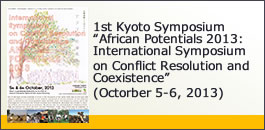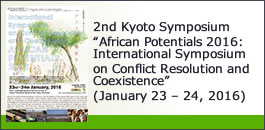[13th Meeting of Research Unit on Culture and Society / 19th Public Workshop] “Ukuringa’-The role of language in negotiating male youth township identity on a south African street corner” Idah Makukule (Public Affairs Research Institute, South Africa, Researcher) (Co-hosted with 25th Kyoto University African Studies Seminar (KUASS), May 26, 2014)
Date: 15:00-17:00, 26 May 2014
Venue: Small Seminar RoomRoom , Inamori Foundation Memorial Bldg. (Inamori Center), Kyoto University
Title: Ukuringa’ -The role of language in negotiating male youth township identity on a south African street corner
Speaker: Idah Makukule (Public Affairs Research Institute, South Africa, Researcher)
Abstract
[10th Meeting of Culture and Society Research Unit / 13th Public Workshop] “Fragmentation, Cooperation and Power: The Institutional Dynamics in Natural Resource Governance in North-western Namibia” (May 14, 2013)
Date: May 14, 2013 (Tue.), 14:30 – 16:30
Venue: Seminar Room (No. 318), Inamori Center, 3F
“Fragmentation, Cooperation and Power: The Institutional Dynamics in Natural Resource Governance in North-western Namibia”
Michael Bollig (Institute for Social and Cultural Anthropology, Vice-Rector for International Relations, Diversity and Academic Career, Universität zu Köln)
Program
14:30 – 16:30 Michael Bollig (Institute for Social and Cultural Anthropology, Vice-Rector for International Relations, Diversity and Academic Career, Universität zu Köln)“Fragmentation, Cooperation and Power: The Institutional Dynamics in Natural Resource Governance in North-western Namibia”
Abstract
Contemporary theoretical accounts of common pool resource management assume that communities are able to develop institutions for sustainable resource management if they are given security of access and appropriate rights of management, and if they can develop institutions that prevent free-riding and over-exploitation. Rural communities have been conceptualized as cornerstones of sustainable and efficient resource management: as a viable alternative to privatizing resources or putting them under state administration. In recent years comprehensive legal reforms of communal rural resource management in Namibia have sought to create an institutional framework linking sustainable land use and rural development. The state, however, ceded rights to communities in an ambiguous and fragmented manner, creating a number of instances of overlapping property rights. Nowadays communities grapple with the challenge of instituting these “new commons”, which are grafted onto earlier communal institutions, but also shaped by state legislation and the engagement of non-governmental organizations. This presentation describes the process of institutional development, focusing on the challenges arising from the necessity to define group boundaries, the issues arising from monitoring and sanctioning within a newly defined common property regime, and the ideological underpinnings of different trajectories of community based natural resource management (CBNRM).[9th Meeting of Culture and Society Research Unit / 12th Public Workshop] “The Urban Working Class Dimensions of Zimbabwe’s War Veterans Revolution: New Empirical Evidence from the Informal Sector” (March 19, 2013)
Date: March 19 (Tue.), 2013, 16:00 – 18:00
Venue: Small Seminar Room-2, Inamori Center 3F.
“The Urban Working Class Dimensions of Zimbabwe’s War Veterans Revolution: New Empirical Evidence from the Informal Sector”
Wilbert Zvakanyorwa Sadomba (Department of Sociology, University of Zimbabwe)
Program
16:00 – 18:00 Wilbert Zvakanyorwa Sadomba (Department of Sociology, University of Zimbabwe)
“The Urban Working Class Dimensions of Zimbabwe’s War Veterans Revolution: New Empirical Evidence from the Informal Sector”
Abstract
The revolution that has been spearheaded by Zimbawean veterans of the 1970s guerrilla war has pushed Africa’s political, social and economic struggles to new horizons. It raises fresh philosophical questions about postcoloniality of and in Africa. The revolution, rooted as it is in the liberation struggle that culminated in a protracted war from the1960s to 1979, lay a political foundation that continues to shape philosophical thought and social practice of this small nation, with ripple effects on the whole continent and perhaps other developing nations across the world. The essence of this revolution is its combined challenge of neo-colonialism and imperialist domination supported by settler economic hegemony. There are four distinct rural and urban movements on which this revolution was anchored, viz. the land, informal mining, housing cooperatives and informal industry and trade movements. A combination of the two books focus on the land and housing cooperatives. Of the five the land movement was the most popularised and internationalised but it was by no means the most dramatic or even the most sustainable but on the contrary it was the most vulnerable to neo-colonial forces and imperialist attacks. However it was also the most symbolical. Current studies on the informal industrial movement add more empirical evidence to this theorisation. Future studies will pursue informal mining as part of the war veterans revolution. The address will illustrate how the war veteran revolution generated a centrifugal force that span the movements and it will discuss relative successes and failures of these in the current political stalemate of the country.
[8th Meeting of Culture and Society Research Unit / 11th Public Workshop] “Human Rights NGOs and Strategies of Public Justice in Sub-Saharan Africa” (February 2, 2013)
Date:Feb.2, 2013 15:00-17:00
Venue: Inamori Foundation Memorial Bldg.
Program
15:00-17:00 Ronald Niezen (Department of Anthropology, McGill University)
“Human Rights NGOs and Strategies of Public Justice in Sub-Saharan Africa”
Abstract
The most significant influence on states that moves them in the direction of human rights compliance involves campaigns of public exposure and protest intended to apply reputational costs to violators of rights. The effectiveness and social consequences of these “politics of shame” vary considerably according to the nature of NGO networks and public participation in justice lobbying. This can be understood by comparison between the claims and strategies of the Tuareg in West Africa and those of the Umoja Women’s village among the Samburu of Kenya. The extension of the international movement of indigenous peoples into sub-Saharan Africa presents an opportunity to consider emerging processes of rights compliance, influenced by trans-national public engagement with distant public audiences.
[6th Meeting of Culture and Society Research Unit / 7th Public Workshop] (Co- organized by the 7th Kyoto University African Studies Seminar (KUASS),October 9, 2012)
Date: Tue., Oct. 09, 2012 15:00-17:30
Venue: Inamori Memorial Foundation, Kyoto University
Chiefdom in Africa: An institution of the past or for the future?
Petr Skalník (University of Hradec Kralove, Czech Republic)
Abstract
Chiefdoms have been in many ways transformed during the colonial and post-colonial times but they still exist in many parts of Africa, Oceania, the Americas and even in Asia. In Europe and non-native America various institutions such as political parties, trade unions, sports clubs and corporations function in ways that resemble chiefdoms. Chieftaincy in Africa is partly discredited and partly revered as a moral authority. In Ghana people and ethnic groups, especially those labeled “acephalous” vie for attaining chiefly status. “Chieftaincy quarrels” lead to armed clashes, unrest and loss of identity. At the same time the modern state in Africa is mostly corrupt, structurally weak or violent towards its own citizens. Chiefs still enjoy high moral status or strive to regain it. At the moment one witnesses revival of chiefdoms’ role as central institution of African society. The solution to the dilemmatic situation might be to “tame” the imported state by according to the chiefs the role of watchdog of democracy. I call it the New Indirect Rule, based on equality of state and chiefdom principles. Is it a wishful thinking or a viable project? What can we learn from Africa?
[4th Culture and Society Unit Meeting] (2012.01.28)
Date: Sat., Jan. 29, 2012 15:00-18:30
Venue: Inamori Memorial Foundation, Kyoto University
Program
15:00~16:00
Misa Hirano (Tenri University)
“The Development Process and Conflicts among Bamileke Chiefdoms in Cameroun”
16:10~17:10
Rumi Umino (Meiji Gakuin University)
“Create History, Connect with Others”: The Techniques to Avoid Conflicts among the Griqua in South Africa”
17:20~18:30
Discussion
Report
Misa Hirano (Tenri University)
“The Development Process and Conflicts among Bamileke Chiefdoms in Cameroun”
Bamileke is a group of people living in the west area of Cameroun and has formed more than 100 chiefdoms. These chiefs were frequently fighting each other before the colonization. In this presentation, by using the oral tradition, it was analyzed how the chiefdoms had been formed. It is possible that some small chiefdoms were already formed in the 16th century. It is conceivable that small groups who moved in during the 17th to 18th century formed new chiefdoms by conquering the local people, and the centralization was furthered through the accumulation of wealth by slave trade, etc. The current system was completed when the German settled in at the end of 19th century.
Inside each chiefdom of Bamileke, frictions and internal disputes between the chiefs and the local residents, the resolution and the coexistence were repeated. And among the chiefdoms, the wars broke out because they insulted each other, which resulted in the territorial expansion of the dominant societies and the formation of identity of each chiefdom. However, there also existed systems to resolve or avoid such conflicts through trading, exchanging captivities and forming marital relations.
Rumi Umino (Meiji Gakuin University)
“Create History, Connect with Others”: The Techniques to Avoid Conflicts among the Griqua in South Africa”
The purpose of this presentation is, by studying the people of Griqua living in Republic of South Africa, to indicate that the practice of what they called “history” itself and the rules manifested through the practice (or something what should be called the premise of conducts) consequently lead to the avoidance of conflict with the others. Griqua people are mainly the descendants of Khoikhoi, with those of the San, European immigrants, Bantu and the released or escaped slaves, who formed themselves by calling themselves “Bastards” by the late 18th century, which includes many communities consisting of the chief and the supporters.
From the middle of 1990’s, they started to be connected to the indigenous people’s working group of United Nations and defined themselves as indigenous. Also, they found out that the other Khoisan from Southern Africa participated in this working group and deepened the exchange and partnership with them. Analyzing that process indicates that there existed three what could be called behavioral principals (= rules), which were deeply related among each other; “accept others”, “rearrange flexibly” and “maintain autonomy”. It seems that those rules and conducts consequently helped them avoiding conflict with others and led to maintain coexisting relationships. (Itaru Ohta)
[3rd Meeting of Culture and Society Research Unit / 3rd Public Workshop] (October 21, 2011)
Date:21 Oct, 2011 15:00-18:00
Venue: Small Seminar Room, 3F Inamori Bldg.,
Kawabata Campus http://www.asafas.kyoto-u.ac.jp/en/about/access.html
Program
15:00-15:10 Introduction
15:10-16:30 John Galaty (McGill University)
“Maasai Land Conflicts and Civil Society: Local Struggles and a Global Audience”
16:30-16:40 Coffee break
16:40-18:00 Junko Maruyama (Tsuda College)
“Resettlement, Development and Indigenous Peoples’ Movement: Two Cases from San Communities in Southern Africa”
Abstract
John Galaty (McGill University)
“Maasai Land Conflicts and Civil Society: Local Struggles and a Global Audience”
The ascendency of the state in Africa and the process of privatizing agrarian land has made many rangeland communities vulnerable to having their mobility drastically curtailed and even to losing their land. This paper will examine the opportunistic seizure of pastoral lands by a variety of actors, including smallholder farmers, political class, entrepreneurs, commercial farmers, speculators, conservationists, tour operators, miners, and foreign states, from the colonial period to the present. From small- to large-scale, valuable pastoral lands have been or are being acquired through local incursions, state allocation or purchase, promising to use it for highly efficient commercial agriculture, or by conservation groups and entrepreneurs who vow to protect wildlife and at the same time propagate high-end lucrative tourist ventures. Land displacements have come to represent a major cause of violent conflicts and legal disputes in pastoral regions. In recent decades, organizations of civil society have increasingly sprung up to defend pastoral land rights, often linking their causes to claims of indigeneity anchored in the creation of the Permanent Forum on Indigenous Issues. The global audience for indigenous land loss and the advocacy of national and international civil society has both mitigated and stimulated local conflicts. Paradoxically, as indigenous land rights have been recognized, actual land loss has accelerated due to the increasingly aggressive role of the state in large-scale land acquisitions by outside parties. This paper will examine the interaction between land grabbing, land losses, and land conflicts, and role played by civil society and assertions of indigenous rights in Eastern and Southern Africa, with special focus on the experience of the Maasai of Kenya and Tanzania.
Junko Maruyama (Tsuda College)
“Resettlement, Development and Indigenous Peoples’ Movement: Two Cases from San Communities in Southern Africa”
The notion that indigenous peoples should have the right to maintain their distinct cultures, lifestyles, and territories has become widely accepted within the international community during the last two decades. While the concept “indigenous peoples” is highly controversial in African context compared with the more consensual situation in nations with white settlers, the San hunter gatherers of Southern Africa also have been involved in global indigenous peoples’ movement, and become one of the best-known “indigenous peoples” in Africa. Indeed, recently some groups of the San have successfully acquired land rights, with the support of the global movement. Of these, two cases from Botswana and South Africa will be highlighted in this presentation; Botswana San won in court the right to return to their land in nature conservation area, and the San in South Africa were handed over land title deeds from President Mandela. Both cases were hailed by NGOs, activists, and the mass media as a landmark for the rights of indigenous peoples in Africa. This presentation will analyze the historical backgrounds and the negotiation process of these two cases, and then elucidate the San’s livelihood and social relationships after they gained land-use rights. Finally, by comparing both cases, dynamics underlying relationships between the San and national and international communities, and positive and negative impacts of the global indigenous peoples’ movement on the San will be discussed.
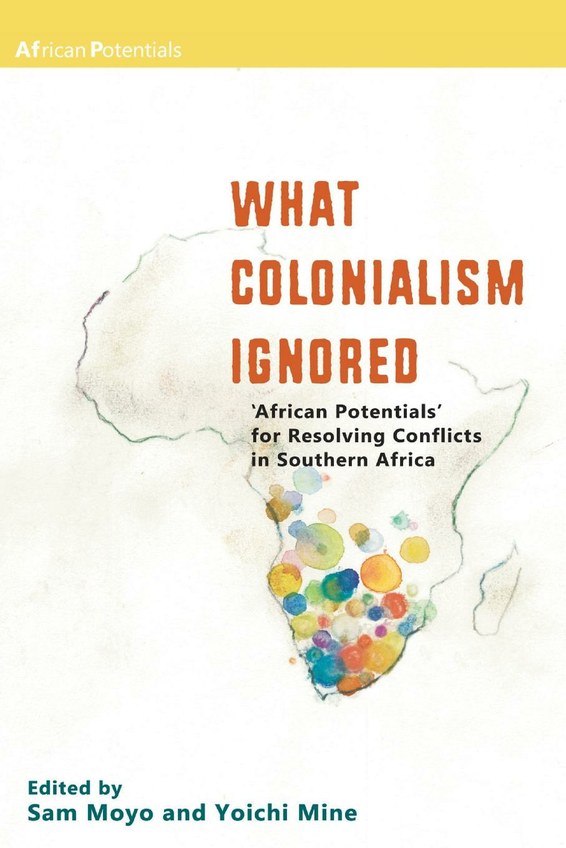
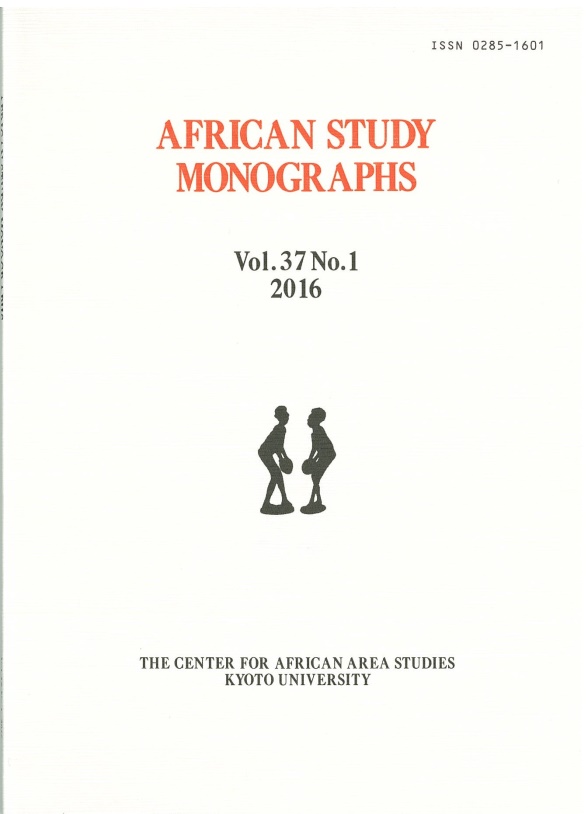
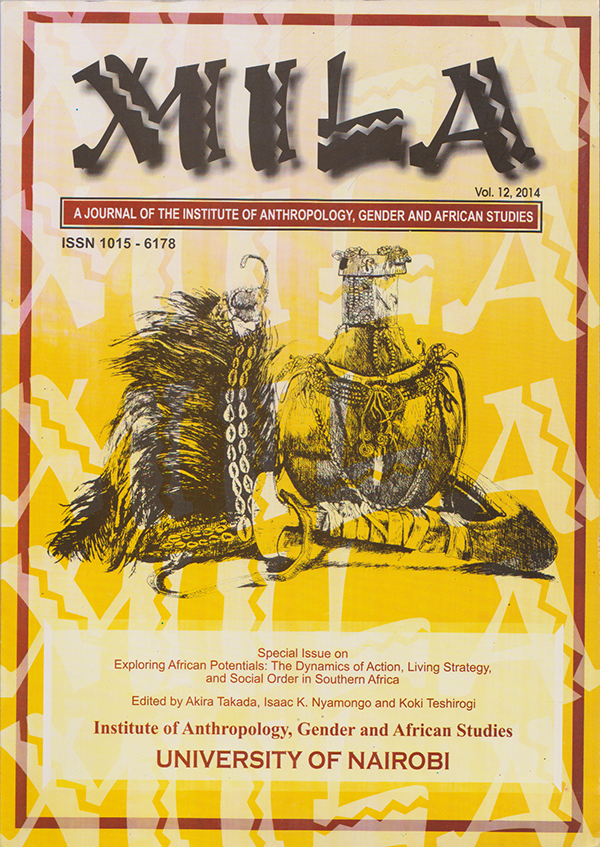 Exploring African Potentials, Mila Special Issue
Exploring African Potentials, Mila Special Issue